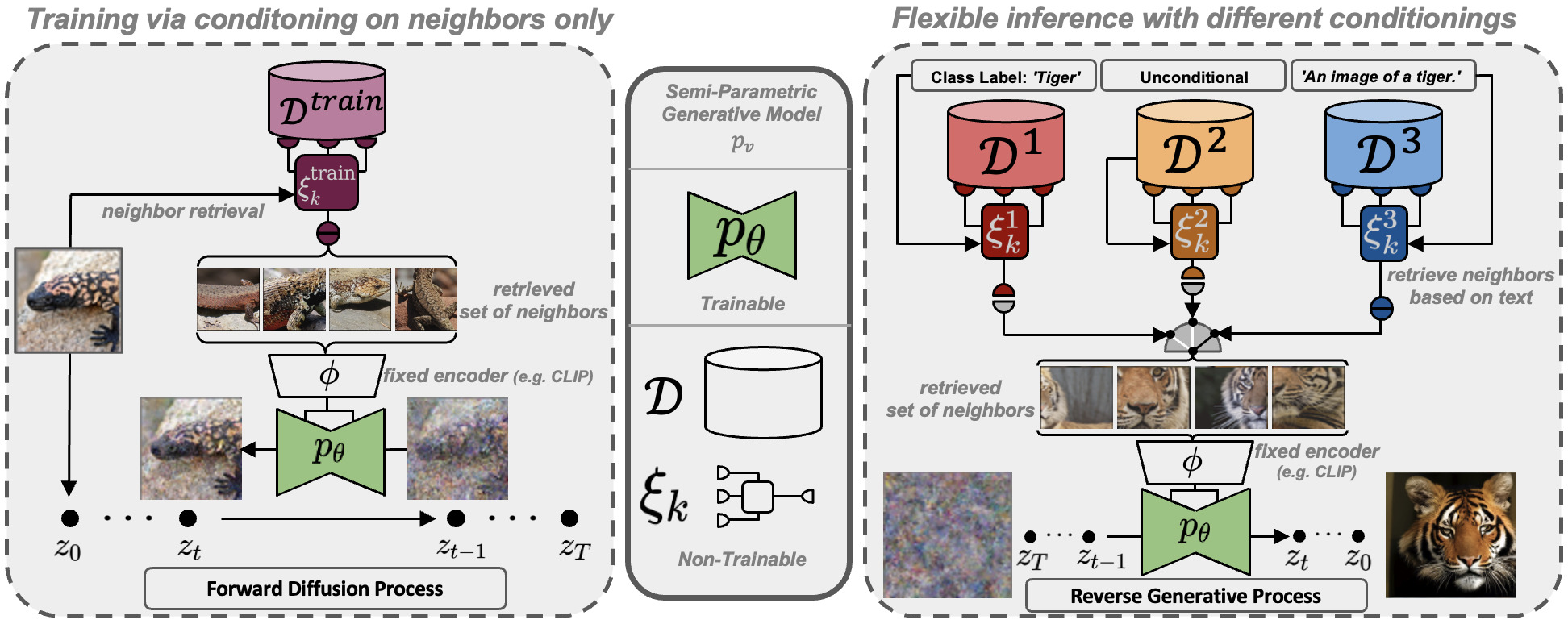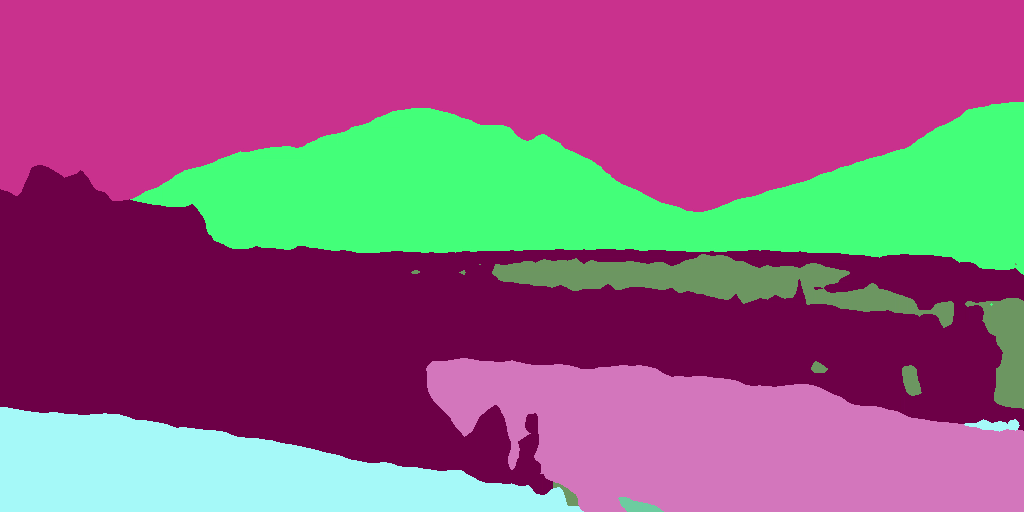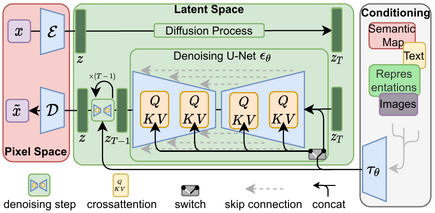High-Resolution Image Synthesis with Latent Diffusion Models
Robin Rombach*,
Andreas Blattmann*,
Dominik Lorenz,
Patrick Esser,
Björn Ommer
* equal contribution
- Inference code and model weights to run our retrieval-augmented diffusion models are now available. See this section.
-
Thanks to Katherine Crowson, classifier-free guidance received a ~2x speedup and the PLMS sampler is available. See also this PR.
-
Our 1.45B latent diffusion LAION model was integrated into Huggingface Spaces 🤗 using Gradio. Try out the Web Demo:
-
More pre-trained LDMs are available:
- A 1.45B model trained on the LAION-400M database.
- A class-conditional model on ImageNet, achieving a FID of 3.6 when using classifier-free guidance Available via a colab notebook
.
A suitable conda environment named ldm can be created
and activated with:
conda env create -f environment.yaml
conda activate ldm
Install Intel optimization for TensorFlow.
conda install tensorflow -c intel
Follow the following links to fix some TensorRT errors caused by missing CUDA libraries.
- tensorflow/tensorflow#57679 (comment)
- https://stackoverflow.com/questions/69917132/could-not-load-dynamic-library-libcudart-so-11-0-in-conda-enviroment
pip install --upgrade setuptools pip
pip install nvidia-pyindex
Install your favorite TensorRT version
- py3.10 -> available from 8.4.0.+
- py3.9 -> available from 8.0.+
- py3.8 -> available from 7.2.2.+
pip install nvidia-tensorrt==7.2.3.4
Verify that TensorRT is installed correctly.
python3 -c "import tensorrt; print(tensorrt.__version__); assert tensorrt.Builder(tensorrt.Logger())"
Create conda_envs/ldm/etc/conda/activate.d/env_vars.sh and add this to the file:
#!/bin/sh
export LD_LIBRARY_PATH="$LD_LIBRARY_PATH:$CONDA_PREFIX/lib"
export LD_LIBRARY_PATH="$LD_LIBRARY_PATH:$CONDA_PREFIX/lib/python3.8/site-packages/tensorrt"
export LD_LIBRARY_PATH="$LD_LIBRARY_PATH:$CONDA_PREFIX/envs/tf/lib"
export LD_LIBRARY_PATH="$LD_LIBRARY_PATH:$CONDA_PREFIX/envs/tf/lib/python3.8/site-packages/tensorrt"Verify that your GPU gets detected.
python3 -c "import tensorflow as tf; print(tf.config.list_physical_devices('GPU'))"
A general list of all available checkpoints is available in via our model zoo. If you use any of these models in your work, we are always happy to receive a citation.
 We include inference code to run our retrieval-augmented diffusion models (RDMs) as described in https://arxiv.org/abs/2204.11824.
We include inference code to run our retrieval-augmented diffusion models (RDMs) as described in https://arxiv.org/abs/2204.11824.
To get started, install the additionally required python packages into your ldm environment
pip install transformers==4.19.2 scann kornia==0.6.4 torchmetrics==0.6.0
pip install git+https://github.com/arogozhnikov/einops.gitand download the trained weights (preliminary ceckpoints):
mkdir -p models/rdm/rdm768x768/
wget -O models/rdm/rdm768x768/model.ckpt https://ommer-lab.com/files/rdm/model.ckptAs these models are conditioned on a set of CLIP image embeddings, our RDMs support different inference modes, which are described in the following.
Since CLIP offers a shared image/text feature space, and RDMs learn to cover a neighborhood of a given example during training, we can directly take a CLIP text embedding of a given prompt and condition on it. Run this mode via
python scripts/knn2img.py --prompt "a happy bear reading a newspaper, oil on canvas"
To be able to run a RDM conditioned on a text-prompt and additionally images retrieved from this prompt, you will also need to download the corresponding retrieval database. We provide two distinct databases extracted from the Openimages- and ArtBench- datasets. Interchanging the databases results in different capabilities of the model as visualized below, although the learned weights are the same in both cases.
Download the retrieval-databases which contain the retrieval-datasets (Openimages (~11GB) and ArtBench (~82MB)) compressed into CLIP image embeddings:
mkdir -p data/rdm/retrieval_databases
wget -O data/rdm/retrieval_databases/artbench.zip https://ommer-lab.com/files/rdm/artbench_databases.zip
wget -O data/rdm/retrieval_databases/openimages.zip https://ommer-lab.com/files/rdm/openimages_database.zip
unzip data/rdm/retrieval_databases/artbench.zip -d data/rdm/retrieval_databases/
unzip data/rdm/retrieval_databases/openimages.zip -d data/rdm/retrieval_databases/We also provide trained ScaNN search indices for ArtBench. Download and extract via
mkdir -p data/rdm/searchers
wget -O data/rdm/searchers/artbench.zip https://ommer-lab.com/files/rdm/artbench_searchers.zip
unzip data/rdm/searchers/artbench.zip -d data/rdm/searchersSince the index for OpenImages is large (~21 GB), we provide a script to create and save it for usage during sampling. Note however, that sampling with the OpenImages database will not be possible without this index. Run the script via
python scripts/train_searcher.pyRetrieval based text-guided sampling with visual nearest neighbors can be started via
python scripts/knn2img.py --prompt "a happy pineapple" --use_neighbors --knn <number_of_neighbors>
Note that the maximum supported number of neighbors is 20.
The database can be changed via the cmd parameter --database which can be [openimages, artbench-art_nouveau, artbench-baroque, artbench-expressionism, artbench-impressionism, artbench-post_impressionism, artbench-realism, artbench-renaissance, artbench-romanticism, artbench-surrealism, artbench-ukiyo_e].
For using --database openimages, the above script (scripts/train_searcher.py) must be executed before.
Due to their relatively small size, the artbench datasetbases are best suited for creating more abstract concepts and do not work well for detailed text control.
- better models
- more resolutions
- image-to-image retrieval
Download the pre-trained weights (5.7GB)
mkdir -p models/ldm/text2img-large/
wget -O models/ldm/text2img-large/model.ckpt https://ommer-lab.com/files/latent-diffusion/nitro/txt2img-f8-large/model.ckpt
and sample with
python scripts/txt2img.py --prompt "a virus monster is playing guitar, oil on canvas" --ddim_eta 0.0 --n_samples 4 --n_iter 4 --scale 5.0 --ddim_steps 50
This will save each sample individually as well as a grid of size n_iter x n_samples at the specified output location (default: outputs/txt2img-samples).
Quality, sampling speed and diversity are best controlled via the scale, ddim_steps and ddim_eta arguments.
As a rule of thumb, higher values of scale produce better samples at the cost of a reduced output diversity.
Furthermore, increasing ddim_steps generally also gives higher quality samples, but returns are diminishing for values > 250.
Fast sampling (i.e. low values of ddim_steps) while retaining good quality can be achieved by using --ddim_eta 0.0.
Faster sampling (i.e. even lower values of ddim_steps) while retaining good quality can be achieved by using --ddim_eta 0.0 and --plms (see Pseudo Numerical Methods for Diffusion Models on Manifolds).
For certain inputs, simply running the model in a convolutional fashion on larger features than it was trained on
can sometimes result in interesting results. To try it out, tune the H and W arguments (which will be integer-divided
by 8 in order to calculate the corresponding latent size), e.g. run
python scripts/txt2img.py --prompt "a sunset behind a mountain range, vector image" --ddim_eta 1.0 --n_samples 1 --n_iter 1 --H 384 --W 1024 --scale 5.0
to create a sample of size 384x1024. Note, however, that controllability is reduced compared to the 256x256 setting.
The example below was generated using the above command.

Download the pre-trained weights
wget -O models/ldm/inpainting_big/last.ckpt https://heibox.uni-heidelberg.de/f/4d9ac7ea40c64582b7c9/?dl=1
and sample with
python scripts/inpaint.py --indir data/inpainting_examples/ --outdir outputs/inpainting_results
indir should contain images *.png and masks <image_fname>_mask.png like
the examples provided in data/inpainting_examples.
Available via a notebook .

We also provide a script for sampling from unconditional LDMs (e.g. LSUN, FFHQ, ...). Start it via
CUDA_VISIBLE_DEVICES=<GPU_ID> python scripts/sample_diffusion.py -r models/ldm/<model_spec>/model.ckpt -l <logdir> -n <\#samples> --batch_size <batch_size> -c <\#ddim steps> -e <\#eta> For downloading the CelebA-HQ and FFHQ datasets, proceed as described in the taming-transformers repository.
The LSUN datasets can be conveniently downloaded via the script available here.
We performed a custom split into training and validation images, and provide the corresponding filenames
at https://ommer-lab.com/files/lsun.zip.
After downloading, extract them to ./data/lsun. The beds/cats/churches subsets should
also be placed/symlinked at ./data/lsun/bedrooms/./data/lsun/cats/./data/lsun/churches, respectively.
The code will try to download (through Academic
Torrents) and prepare ImageNet the first time it
is used. However, since ImageNet is quite large, this requires a lot of disk
space and time. If you already have ImageNet on your disk, you can speed things
up by putting the data into
${XDG_CACHE}/autoencoders/data/ILSVRC2012_{split}/data/ (which defaults to
~/.cache/autoencoders/data/ILSVRC2012_{split}/data/), where {split} is one
of train/validation. It should have the following structure:
${XDG_CACHE}/autoencoders/data/ILSVRC2012_{split}/data/
├── n01440764
│ ├── n01440764_10026.JPEG
│ ├── n01440764_10027.JPEG
│ ├── ...
├── n01443537
│ ├── n01443537_10007.JPEG
│ ├── n01443537_10014.JPEG
│ ├── ...
├── ...
If you haven't extracted the data, you can also place
ILSVRC2012_img_train.tar/ILSVRC2012_img_val.tar (or symlinks to them) into
${XDG_CACHE}/autoencoders/data/ILSVRC2012_train/ /
${XDG_CACHE}/autoencoders/data/ILSVRC2012_validation/, which will then be
extracted into above structure without downloading it again. Note that this
will only happen if neither a folder
${XDG_CACHE}/autoencoders/data/ILSVRC2012_{split}/data/ nor a file
${XDG_CACHE}/autoencoders/data/ILSVRC2012_{split}/.ready exist. Remove them
if you want to force running the dataset preparation again.
Logs and checkpoints for trained models are saved to logs/<START_DATE_AND_TIME>_<config_spec>.
Configs for training a KL-regularized autoencoder on ImageNet are provided at configs/autoencoder.
Training can be started by running
CUDA_VISIBLE_DEVICES=<GPU_ID> python main.py --base configs/autoencoder/<config_spec>.yaml -t --gpus 0,
where config_spec is one of {autoencoder_kl_8x8x64(f=32, d=64), autoencoder_kl_16x16x16(f=16, d=16),
autoencoder_kl_32x32x4(f=8, d=4), autoencoder_kl_64x64x3(f=4, d=3)}.
For training VQ-regularized models, see the taming-transformers repository.
In configs/latent-diffusion/ we provide configs for training LDMs on the LSUN-, CelebA-HQ, FFHQ and ImageNet datasets.
Training can be started by running
CUDA_VISIBLE_DEVICES=<GPU_ID> python main.py --base configs/latent-diffusion/<config_spec>.yaml -t --gpus 0,where <config_spec> is one of {celebahq-ldm-vq-4(f=4, VQ-reg. autoencoder, spatial size 64x64x3),ffhq-ldm-vq-4(f=4, VQ-reg. autoencoder, spatial size 64x64x3),
lsun_bedrooms-ldm-vq-4(f=4, VQ-reg. autoencoder, spatial size 64x64x3),
lsun_churches-ldm-vq-4(f=8, KL-reg. autoencoder, spatial size 32x32x4),cin-ldm-vq-8(f=8, VQ-reg. autoencoder, spatial size 32x32x4)}.
All models were trained until convergence (no further substantial improvement in rFID).
| Model | rFID vs val | train steps | PSNR | PSIM | Link | Comments |
|---|---|---|---|---|---|---|
| f=4, VQ (Z=8192, d=3) | 0.58 | 533066 | 27.43 +/- 4.26 | 0.53 +/- 0.21 | https://ommer-lab.com/files/latent-diffusion/vq-f4.zip | |
| f=4, VQ (Z=8192, d=3) | 1.06 | 658131 | 25.21 +/- 4.17 | 0.72 +/- 0.26 | https://heibox.uni-heidelberg.de/f/9c6681f64bb94338a069/?dl=1 | no attention |
| f=8, VQ (Z=16384, d=4) | 1.14 | 971043 | 23.07 +/- 3.99 | 1.17 +/- 0.36 | https://ommer-lab.com/files/latent-diffusion/vq-f8.zip | |
| f=8, VQ (Z=256, d=4) | 1.49 | 1608649 | 22.35 +/- 3.81 | 1.26 +/- 0.37 | https://ommer-lab.com/files/latent-diffusion/vq-f8-n256.zip | |
| f=16, VQ (Z=16384, d=8) | 5.15 | 1101166 | 20.83 +/- 3.61 | 1.73 +/- 0.43 | https://heibox.uni-heidelberg.de/f/0e42b04e2e904890a9b6/?dl=1 | |
| f=4, KL | 0.27 | 176991 | 27.53 +/- 4.54 | 0.55 +/- 0.24 | https://ommer-lab.com/files/latent-diffusion/kl-f4.zip | |
| f=8, KL | 0.90 | 246803 | 24.19 +/- 4.19 | 1.02 +/- 0.35 | https://ommer-lab.com/files/latent-diffusion/kl-f8.zip | |
| f=16, KL (d=16) | 0.87 | 442998 | 24.08 +/- 4.22 | 1.07 +/- 0.36 | https://ommer-lab.com/files/latent-diffusion/kl-f16.zip | |
| f=32, KL (d=64) | 2.04 | 406763 | 22.27 +/- 3.93 | 1.41 +/- 0.40 | https://ommer-lab.com/files/latent-diffusion/kl-f32.zip |
Running the following script downloads und extracts all available pretrained autoencoding models.
bash scripts/download_first_stages.shThe first stage models can then be found in models/first_stage_models/<model_spec>
| Datset | Task | Model | FID | IS | Prec | Recall | Link | Comments |
|---|---|---|---|---|---|---|---|---|
| CelebA-HQ | Unconditional Image Synthesis | LDM-VQ-4 (200 DDIM steps, eta=0) | 5.11 (5.11) | 3.29 | 0.72 | 0.49 | https://ommer-lab.com/files/latent-diffusion/celeba.zip | |
| FFHQ | Unconditional Image Synthesis | LDM-VQ-4 (200 DDIM steps, eta=1) | 4.98 (4.98) | 4.50 (4.50) | 0.73 | 0.50 | https://ommer-lab.com/files/latent-diffusion/ffhq.zip | |
| LSUN-Churches | Unconditional Image Synthesis | LDM-KL-8 (400 DDIM steps, eta=0) | 4.02 (4.02) | 2.72 | 0.64 | 0.52 | https://ommer-lab.com/files/latent-diffusion/lsun_churches.zip | |
| LSUN-Bedrooms | Unconditional Image Synthesis | LDM-VQ-4 (200 DDIM steps, eta=1) | 2.95 (3.0) | 2.22 (2.23) | 0.66 | 0.48 | https://ommer-lab.com/files/latent-diffusion/lsun_bedrooms.zip | |
| ImageNet | Class-conditional Image Synthesis | LDM-VQ-8 (200 DDIM steps, eta=1) | 7.77(7.76)* /15.82** | 201.56(209.52)* /78.82** | 0.84* / 0.65** | 0.35* / 0.63** | https://ommer-lab.com/files/latent-diffusion/cin.zip | *: w/ guiding, classifier_scale 10 **: w/o guiding, scores in bracket calculated with script provided by ADM |
| Conceptual Captions | Text-conditional Image Synthesis | LDM-VQ-f4 (100 DDIM steps, eta=0) | 16.79 | 13.89 | N/A | N/A | https://ommer-lab.com/files/latent-diffusion/text2img.zip | finetuned from LAION |
| OpenImages | Super-resolution | LDM-VQ-4 | N/A | N/A | N/A | N/A | https://ommer-lab.com/files/latent-diffusion/sr_bsr.zip | BSR image degradation |
| OpenImages | Layout-to-Image Synthesis | LDM-VQ-4 (200 DDIM steps, eta=0) | 32.02 | 15.92 | N/A | N/A | https://ommer-lab.com/files/latent-diffusion/layout2img_model.zip | |
| Landscapes | Semantic Image Synthesis | LDM-VQ-4 | N/A | N/A | N/A | N/A | https://ommer-lab.com/files/latent-diffusion/semantic_synthesis256.zip | |
| Landscapes | Semantic Image Synthesis | LDM-VQ-4 | N/A | N/A | N/A | N/A | https://ommer-lab.com/files/latent-diffusion/semantic_synthesis.zip | finetuned on resolution 512x512 |
The LDMs listed above can jointly be downloaded and extracted via
bash scripts/download_models.shThe models can then be found in models/ldm/<model_spec>.
- More inference scripts for conditional LDMs.
- In the meantime, you can play with our colab notebook https://colab.research.google.com/drive/1xqzUi2iXQXDqXBHQGP9Mqt2YrYW6cx-J?usp=sharing
-
Our codebase for the diffusion models builds heavily on OpenAI's ADM codebase and https://github.com/lucidrains/denoising-diffusion-pytorch. Thanks for open-sourcing!
-
The implementation of the transformer encoder is from x-transformers by lucidrains.
@misc{rombach2021highresolution,
title={High-Resolution Image Synthesis with Latent Diffusion Models},
author={Robin Rombach and Andreas Blattmann and Dominik Lorenz and Patrick Esser and Björn Ommer},
year={2021},
eprint={2112.10752},
archivePrefix={arXiv},
primaryClass={cs.CV}
}
@misc{https://doi.org/10.48550/arxiv.2204.11824,
doi = {10.48550/ARXIV.2204.11824},
url = {https://arxiv.org/abs/2204.11824},
author = {Blattmann, Andreas and Rombach, Robin and Oktay, Kaan and Ommer, Björn},
keywords = {Computer Vision and Pattern Recognition (cs.CV), FOS: Computer and information sciences, FOS: Computer and information sciences},
title = {Retrieval-Augmented Diffusion Models},
publisher = {arXiv},
year = {2022},
copyright = {arXiv.org perpetual, non-exclusive license}
}





